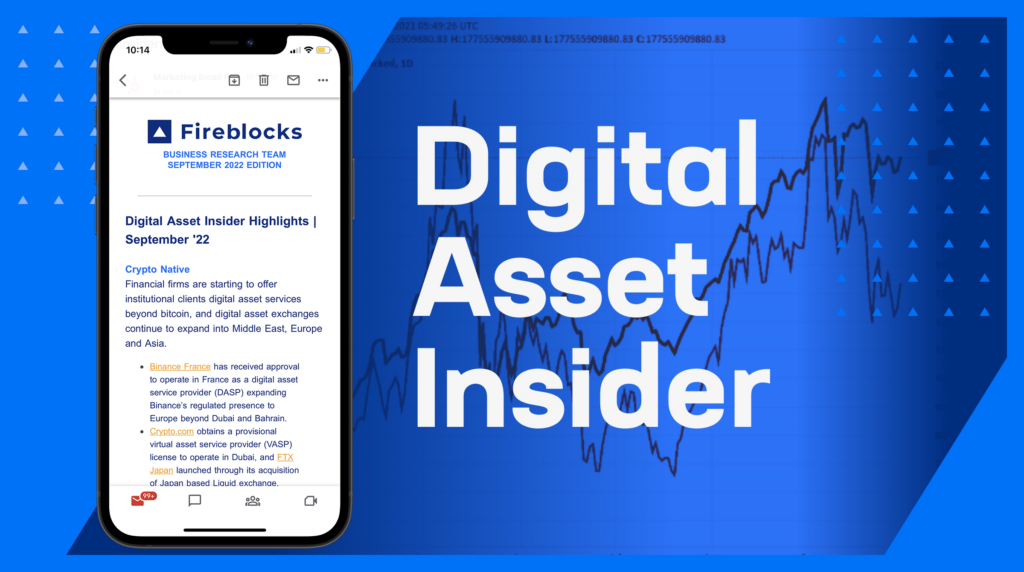Digital asset markets traded sideways in August. Tokenization application to traditional asset classes is moving towards becoming a reality as more financial and commercial firms look to adopt and build out digital asset infrastructure to support existing and new business opportunities using blockchain technologies. Crypto-native projects continue to develop their business and use this “quiet” period in the market to innovate.
We just wrapped our inaugural Fireblocks User Conference, SPARK ’22, on Monday! This month’s Digital Asset Insider is slightly delayed as a result, so thank you for your patience, Insiders. We’ll be sharing insights and learnings from the event next month — stay tuned!
Crypto Native
Traditional asset managers are giving clients access to products with digital assets exposure. Investments are focused on companies that provide services to digital asset investors, or in the underlying blockchain technology. Products and services with investments made directly into digital assets are only offered to institutional investors.
- BlackRock and Coinbase announced a new partnership to provide Blackrock institutional clients direct access to crypto, starting with Bitcoin. Coinbase will provide trading, custody, prime brokerage and reporting capabilities through BlackRock’s Aladdin platform.
- Indirect exposure to digital assets come in the form of investments into firms providing services to the industry. Investment firm, Abrdn, has taken a stake in Archax, a digital exchange based in the United Kingdom, and Charles Schwab launched an exchange traded fund investing in digital asset companies.
- The United States Federal Reserve is opening a pathway for crypto banks (like Kraken Bank and Custodia) to connect to the global payment system through its “master accounts”. The guidance proposed by the central bank would provide a tiered system that includes giving access to firms “not federally insured and not subject to prudential supervision by a federal banking agency”.
- DBS Bank Digital Exchange, an early mover in offering access to institutional investors to digital assets, has seen trading volumes increase significantly despite the overall fall in the digital asset markets. The number of trades in June doubled that of April, with even more digital assets being stored in custody.
Tokenization
Tokenization of real world assets, commodities, funds, equities, and debt is closer to being made a reality as traditional financial firms take steps to acquire the technology and know-how through proof-of-concept projects. In our white paper, “Tokenization: The Foundation of Digital Financial Markets”, we outlined many of the key considerations for financial institutions to strategically position themselves to take advantage of this technology.
- Zerocap, an Australian digital asset exchange, has successfully completed a proof-of-concept trial of the trading and clearing of tokenized assets as part of the Australian Securities Exchange (ASX) Synfini platform project. This could pave the way for the trading of tokenized bonds, equities, funds, or carbon credits.
- The chief executive of the World Gold Council believes in the digitization of gold as a trusted asset. This would involve defining criteria such as shape, size and provenance (historical origination) of gold. The tokenization of gold would allow the trading of gold to occur without its physical movement and allow greater retail participation.
- Asset tokenization firm Koibanx has raised $22 million in a Series A funding round led by Algorand Inc., with the proceeds to be used to build payment rails for financial institutions in Central America. Koibanx had worked with El Salvador’s government to develop the country’s blockchain infrastructure and payments network connected to the Chivo bitcoin wallet.
Web3
More Non-fungible token (NFT) use cases around gaming, art, and collectibles are adopting blockchain to engage fans and users. As the NFT ecosystem continues to grow, they are more vulnerable to hackers. Custody technology solutions that do not provide adequate security expose Web3 platforms to hackers who are able to exploit weaknesses in their tech stack and their users’ wallets. Secure infrastructure needs to be considered from inception, which includes the ability to set authorization transfer limits, and be able to scale as the business grows.
- Elliptic has reported over $100 million in non-fungible tokens (NFTs) have been stolen in the last 12 months. Exploits include phishing scams, Trojan horse NFTs, and NFT swap scams.
- Animoca Brand’s Japanese unit raised $45 million including funds from one of Japan’s largest banks, MUFG Bank. The funds will be used to invest in companies and local licenses.
- Thirdweb, a Web3 focused development firm, raised $24 million in a Series A funding round. The company provides developers a toolkit to build and launch Web3 products – games, NFTs, DAOs and marketplaces – with features that include smart contracts, publishing tools and logins.
Digital Asset Infrastructure
Crypto exchanges are leveraging their blockchain technology expertise to offer services to build infrastructure and develop ecosystems, which provide their partners with new economic and business growth opportunities. Stablecoin adoption gains increased access to institutional clients with digital asset infrastructure support.
- Binance will be supporting the South Korean city of Busan, home to the country’s largest sea port, to develop the city’s blockchain infrastructure and ecosystem. At the same time, Bahamas-based crypto exchange FTX will work with the city to develop and promote blockchain-focused businesses. Both Binance and FTX will support the establishment of the Busan Digital Asset Exchange. Busan has established a blockchain regulatory-free zone to promote blockchain initiatives and businesses.
- The British Pound stablecoin, poundtoken (GBPT), launched by blackfridge has been made available to users of the Fireblocks Network. The GBPT is a Financial Services Authority regulated stablecoin fully backed 1:1 by pound sterling which is kept in reserves audited by financial audit firm KPMG. The Fireblocks Network counts crypto-native exchange and hedge funds, banks, fintech and payment firms as clients, allowing the secure and seamless transfer of digital assets.
Regulation | Regulators
Governments and financial regulators are increasing efforts for the regulation of digital assets and stablecoins to address risk. Dubai continues to attract firms providing digital asset services to be licensed.
- The Monetary Authority of Singapore (MAS) has requested business data from crypto firms as it ramps up its plans for regulatory changes. The MAS also plans to seek public consultation on stablecoins in the near future to assess their characteristics and risk, with regulations potentially setting reserve requirements.
- The Australian Government plans to map digital asset tokens being used in Australia as part of the government’s plan to understand how they may be regulated. The Australian regulatory and licensing framework will be reviewed to identify gaps, which includes obligations around the custody of digital assets.
- Koumainu receives a provisional virtual asset service provider license to operate in Dubai. The firm, which counts Japanese investment bank Noumura as an investor, will be allowed to offer institutions access to Bitcoin and digital asset custody services out of the country.
CBDCs
Wholesale CBDC projects remain the focus of central banks announcements as they explore the use cases and potential benefits and implications of a CBDC. China continues to expand the use of the e-Yuan in pilot projects in the public transportation networks of large cities.
- The Reserve Bank of Australia will explore retail CBDC use cases within a closed-loop environment in a pilot research project with the Digital Finance Cooperative Research Centre (DFCRC). The central bank still sees a wholesale CBDC as more likely to support wholesale transactions given the focus of other central banks.
- The governor of Indonesia’s central bank, Bank Indonesia, is expected to release the expected design of a wholesale focused CBDC by the end of 2022, the digital rupiah. The bank is looking to distribute the digital rupiah through intermediaries like smaller banks and payment service companies for retail transactions.
- China’s e-Yuan has reached another milestone in testing the use of the central bank issued digital currency for payments when traveling on public transport in a number of Chinese cities including Guangzhou and Ningbo. E-commerce platforms such as Meituan and JD.com had partnered with the government to accept the e-CNY as legal tender for purchases.
Regenerative Finance
Carbon credit trading venue developments are important to price carbon at meaningful prices and support climate-focused projects. Carbon pricing plans are being reviewed to also ensure genuine carbon reducing initiatives are undertaken.
- Global carbon trade is currently worth $172 billion annually, according to the United Nations Development Programme (UNDP). Carbon credits benefit the climate by either removing carbon dioxide from the air or prevent it from being emitted. Trading carbon credits enable the ability for the market to price carbon to market prices.
- Carbon credit pricing and taxes in Asia is far below Europe in having a meaningful impact on polluter behavior. Governments are forming carbon pricing plans to support genuine carbon reducing initiatives.
- World Bank affiliate International Finance Corp (IFC) is backing Chia Network to trade carbon credit tokens. IFC intends to attract institutional investors for climate friendly projects in emerging markets.
Crypto-Native Market Analytics
Total Market Capitalization (TMC) held above $1 trillion in August as crypto-native prices recovered modestly over the month. The corrective price movement observed was in tandem with traditional risk-oriented assets such as equities which also saw higher prices. Central banks raised interest rates across the board between 25 to 75 basis points in an attempt to tame price inflation felt by economies around the world and mitigate the chances of economic recession.
MONTHLY CHANGE
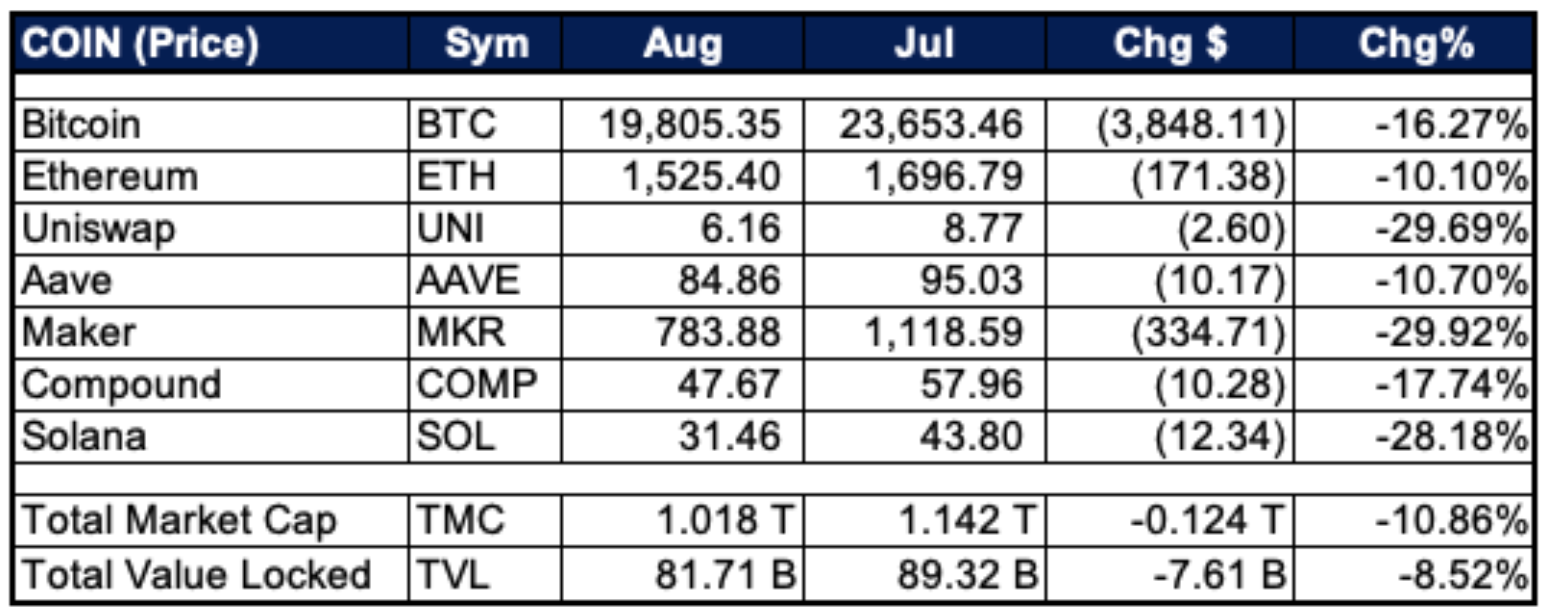
Crypto-native markets ended August lower as risk-oriented asset markets continued to face pressure in the backdrop of higher interest rates.
TOP 10 MARKET CAPITALIZATION
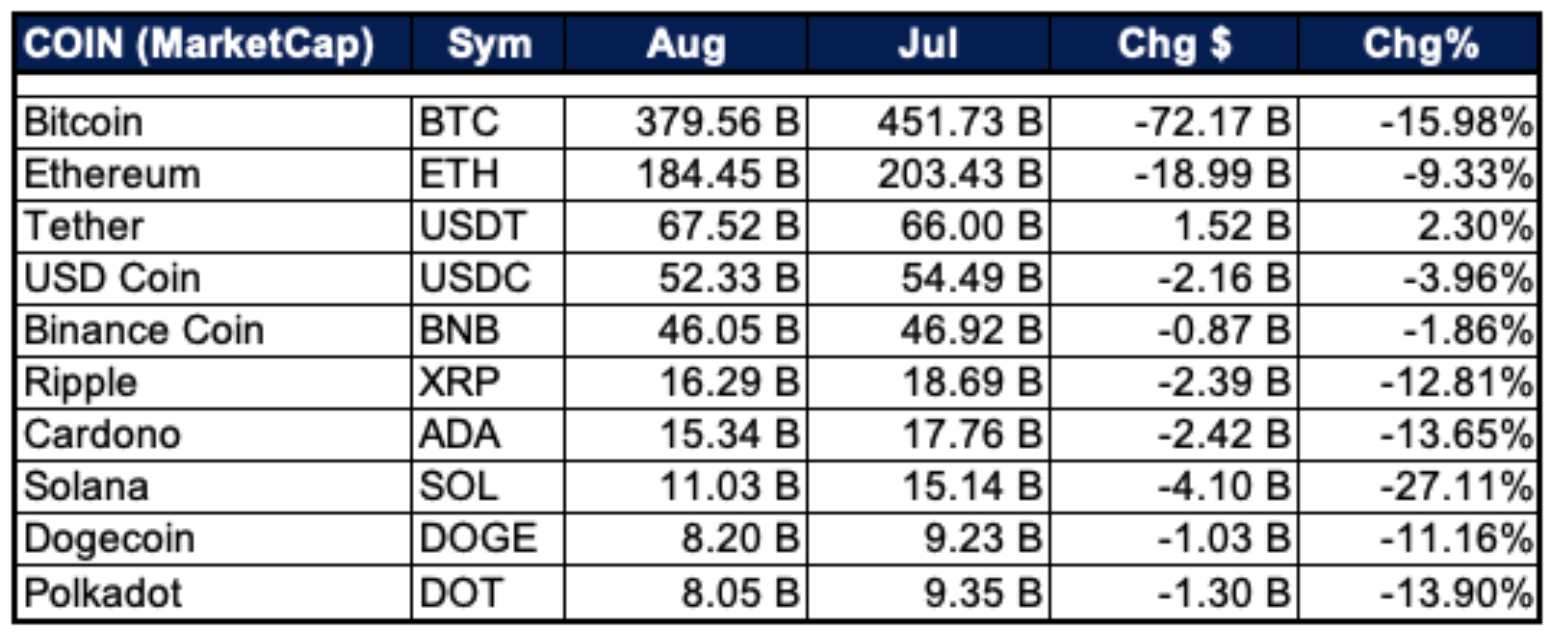
Digital asset markets fell slightly in August. Solana was an exception with a 27% drop.
BITCOIN [BTC]
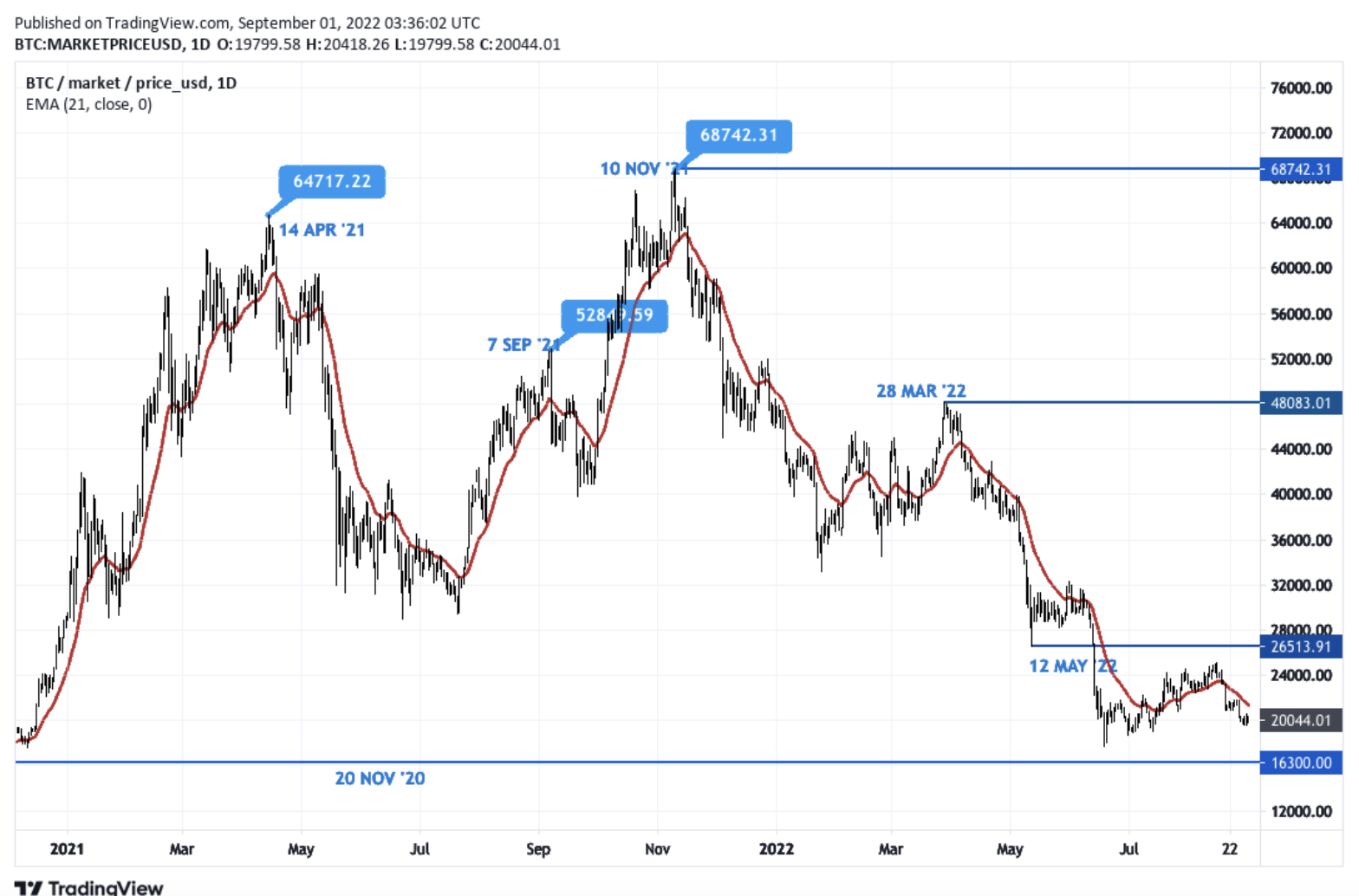
Bitcoin reached $25,000 but could not gain any momentum higher.
BITCOIN: STOCK TO FLOW RATIO [BTC:STFR]
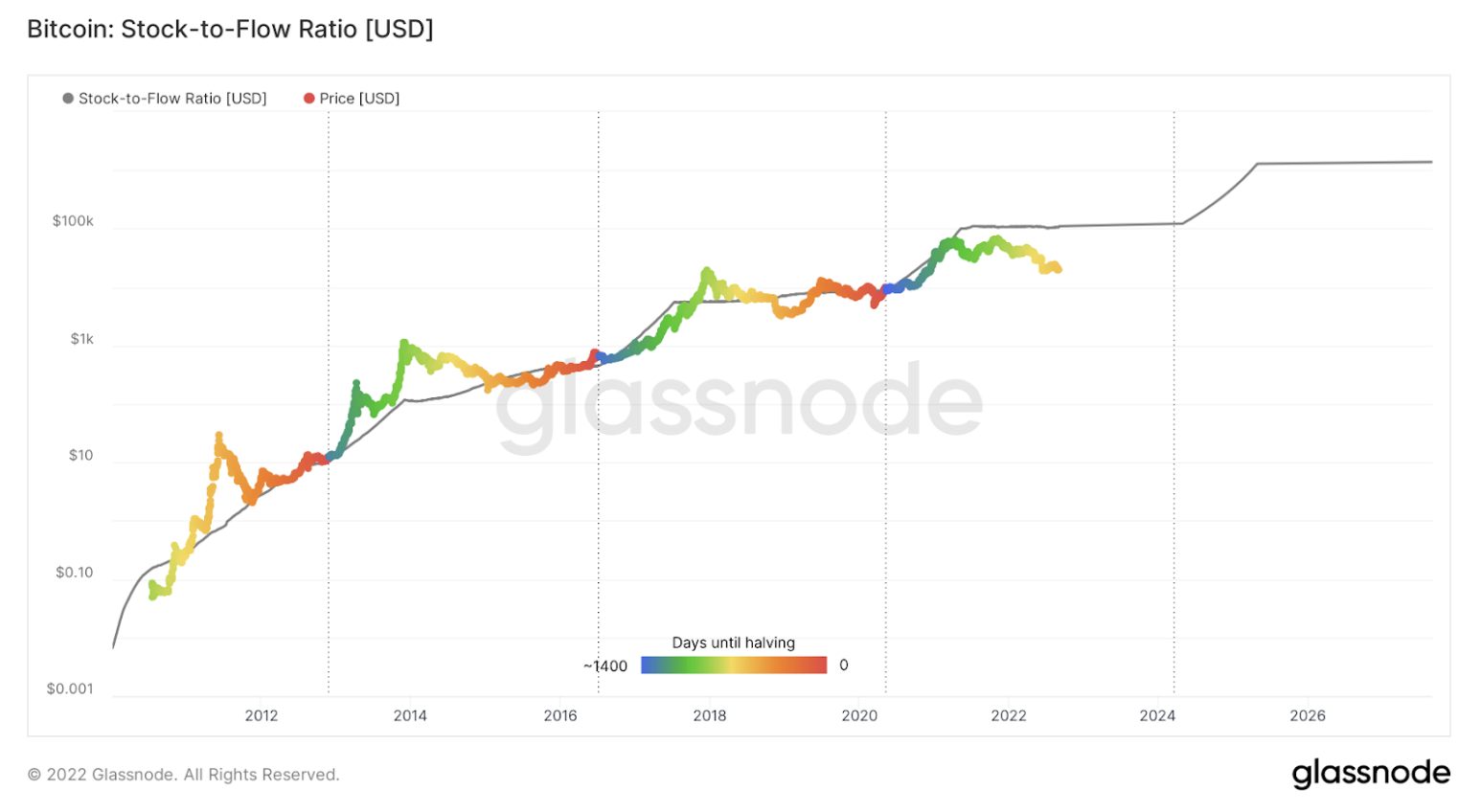
BTC is lower than STFR, indicating it is undervalued.
BTC: ALL EXCHANGES NETFLOW
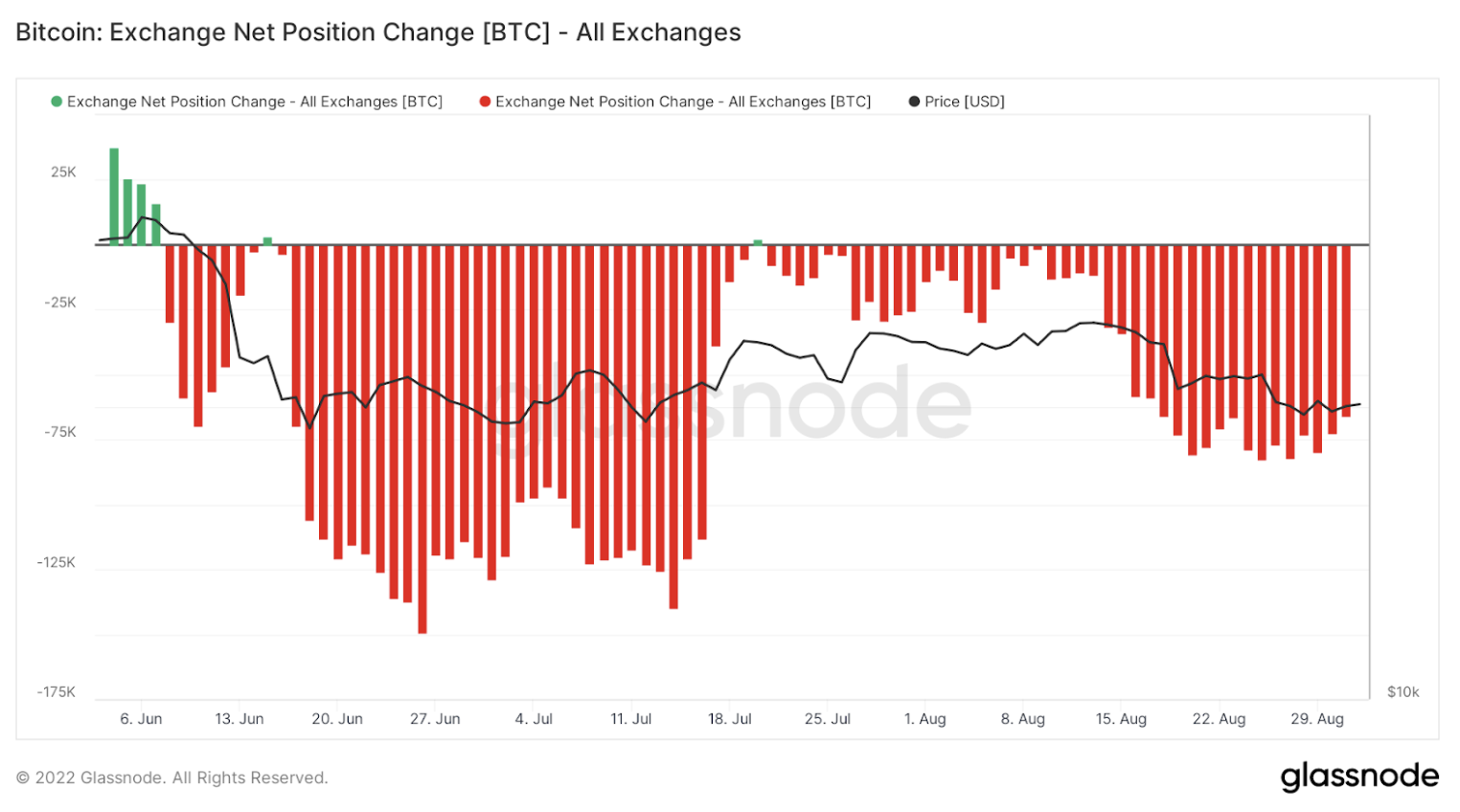
Net position change saw a slow pace of net outflows from exchanges at the beginning of the month as prices inched higher and strengthened as weakness continued in the second half of the month.
REGIONAL BTC FLOWS [Last 7 Day Average, Sep 1]
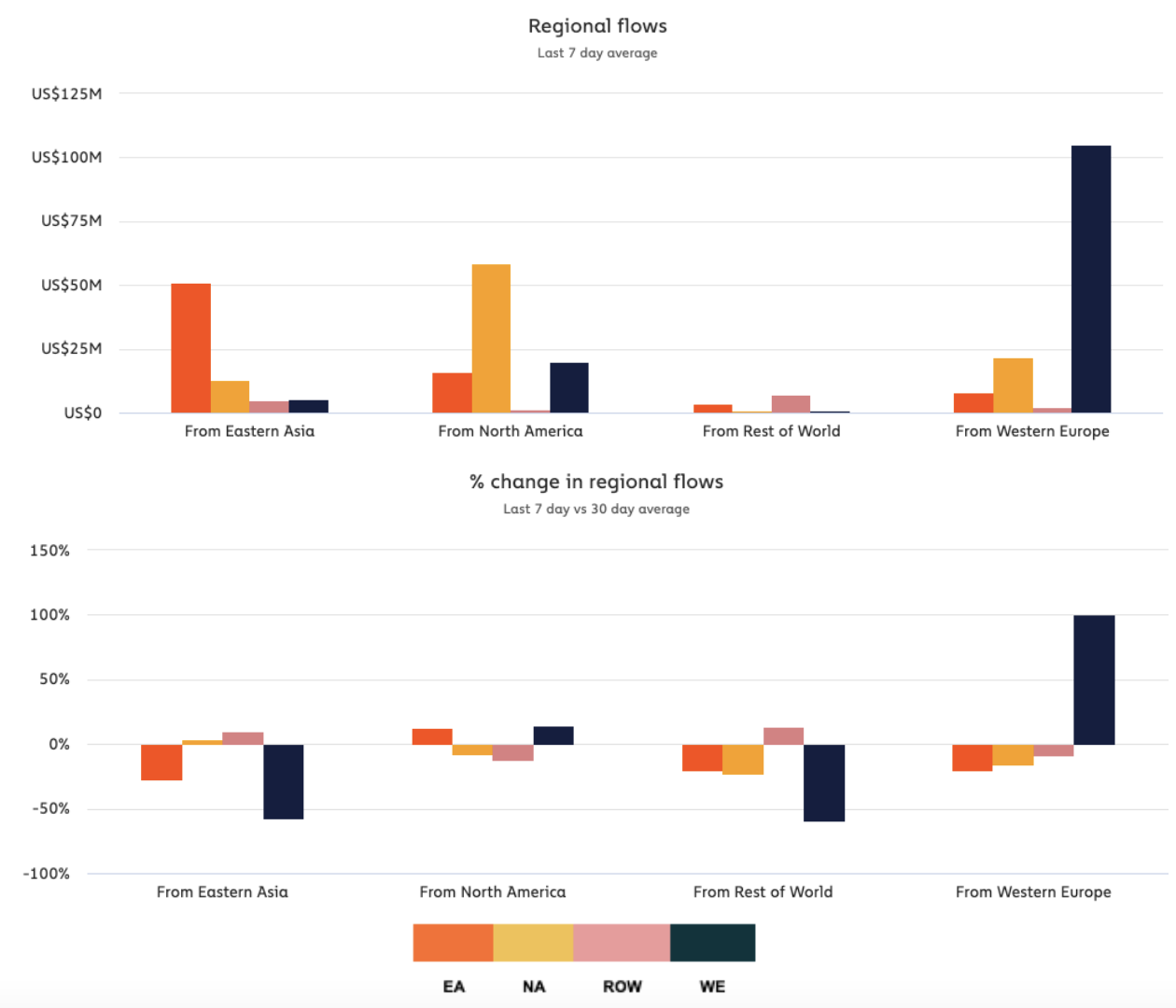
Intra-regional flows saw a jump at the end of August in Western Europe.
From a percentage change perspective, the stronger flows within Western Europe increased over 100% in the last 7 days versus the 30 day average.
Assets typically flow within a region, likely due to preferences for local exchanges, but flows between regions often occur as a result of regulatory concerns, geopolitical changes, or significant market price variations.
ETHEREUM [ETH]
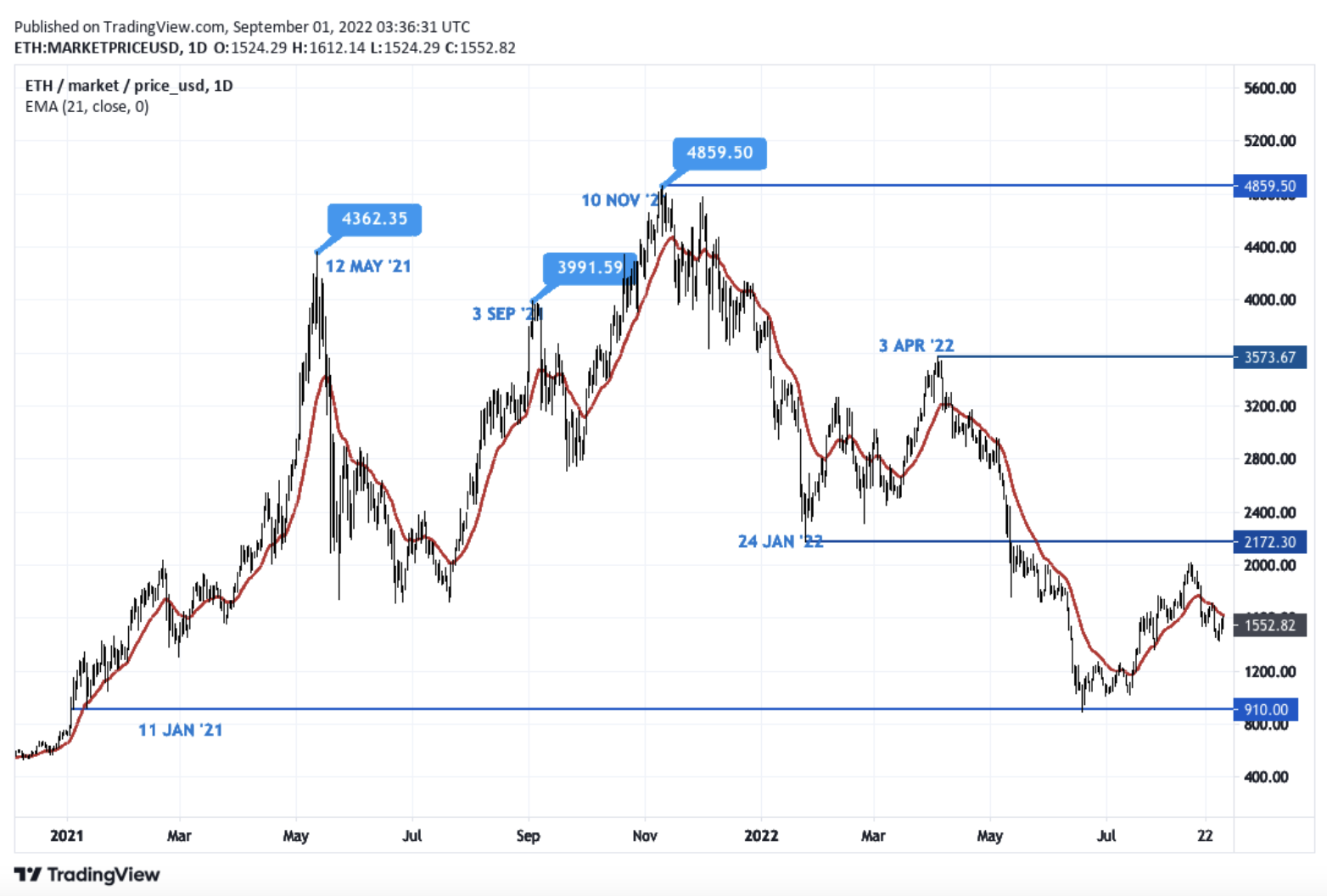
Ethereum reached $2,000 mid-month and fell back down towards $1,500 as the month came to a close.
TOTAL VALUE LOCKED [TVL, Aug 31]
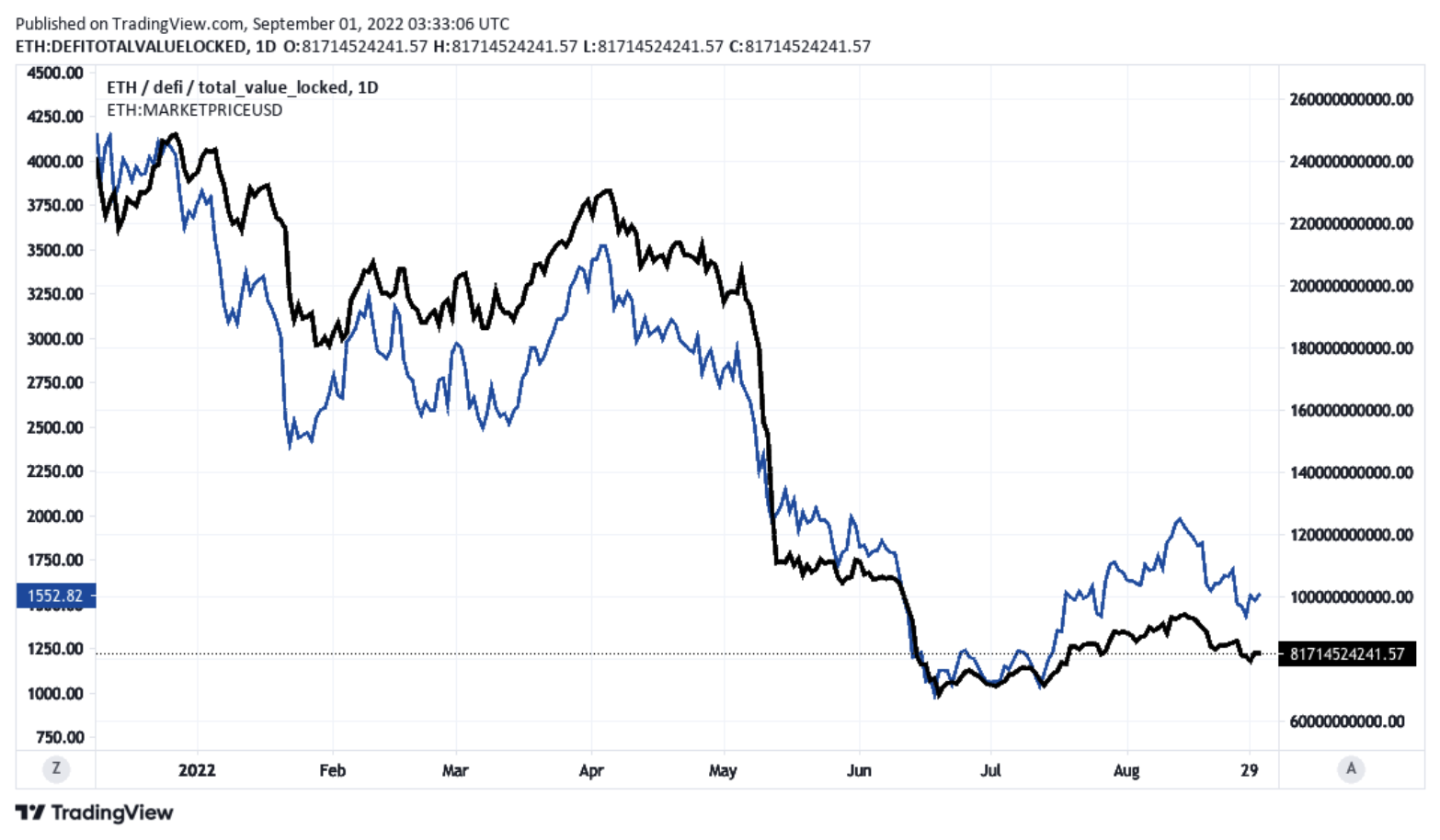
DeFi TVL rose in tandem to the slow recovery in ETH.
PROTOCOL POSITION [TVL, Aug 31]

Total value locked (TVL) for all the protocols ranking behind Ethereum was mixed with Solana and Avalanche falling the most.
DEFI PULSE INDEX [DPI]
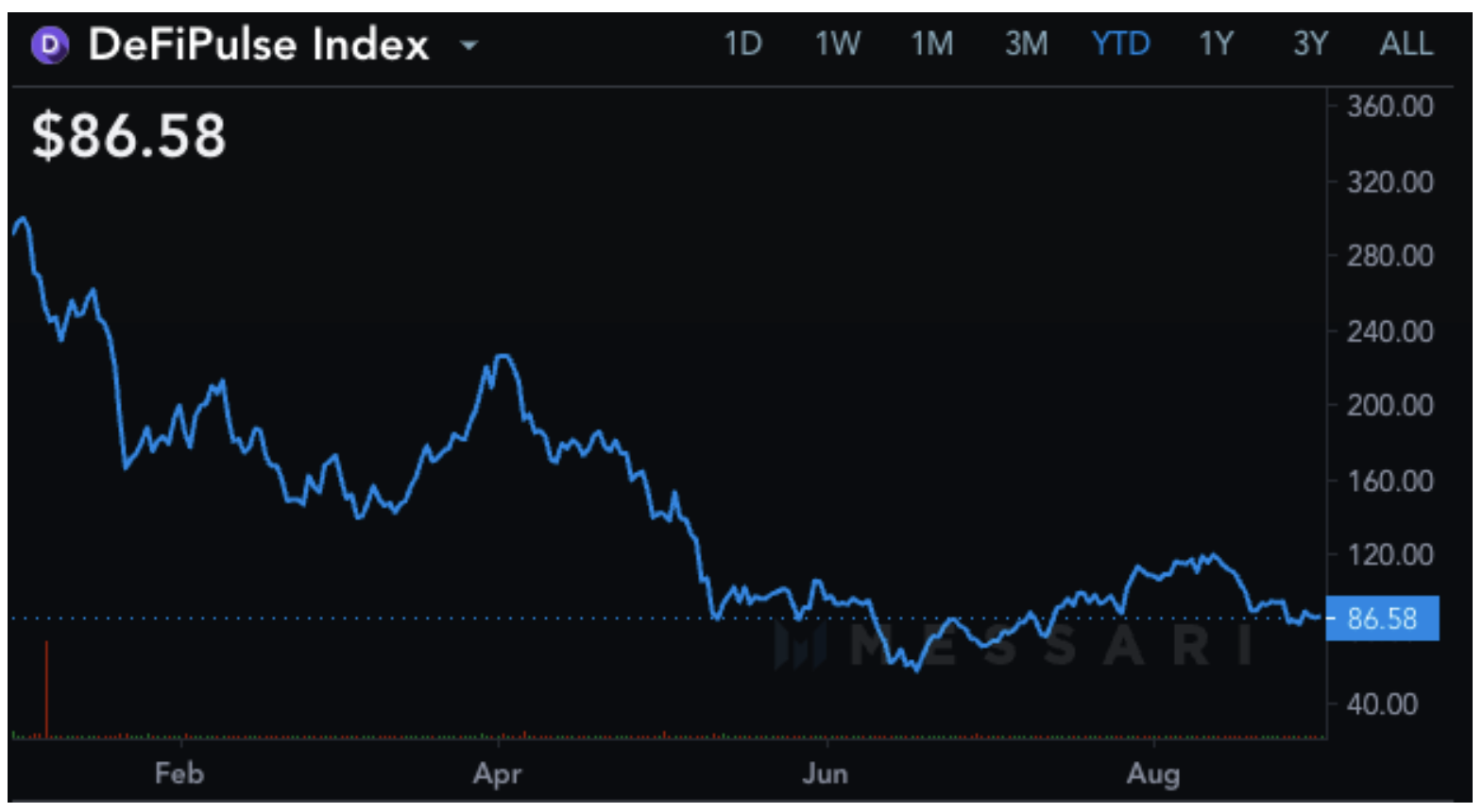
Top 5 Tokens: Uniswap, Aave, Maker, Loopring and Synthetix.
Index information can be found at the Tokensets.com.
This reCap is distributed for general informational and educational purposes only and is not intended to constitute legal, tax, accounting, or investment advice. For other important disclosures.



